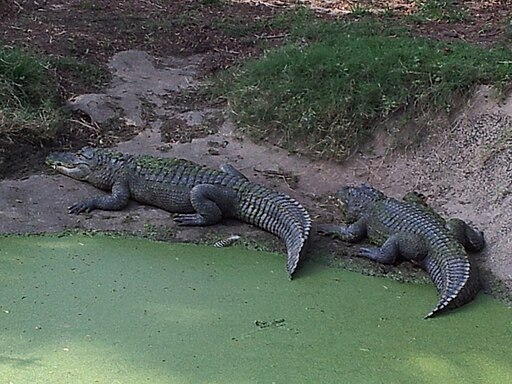Eastern Diamondback Rattlesnake

As the largest venomous snake in North America, the Eastern Diamondback Rattlesnake holds a formidable reputation. This impressive serpent, which can reach up to eight feet in length, is native to the coastal plains of Georgia. It’s easily recognizable by its dark diamond-shaped patterns along its back. The snake’s venom is potent enough to require immediate medical attention if bitten, but it generally prefers to avoid human contact, warning of its presence with the distinctive rattle at the end of its tail. Despite its fearsome appearance, the snake plays a vital role in controlling rodent populations.
American Alligator

The American Alligator is a common yet intimidating presence in Georgia’s wetlands, rivers, and coastal areas. Growing up to 13 feet long, these powerful predators are known for their strong jaws and stealthy nature. Alligators primarily feed on fish, birds, and small mammals. While they generally shy away from humans, caution is advised in their habitats, especially during mating season when they can become more territorial. Conservation efforts have successfully increased their numbers, making encounters with these ancient reptiles more common in the state.
Black Widow Spider

The Black Widow Spider is infamous for the red hourglass marking on its abdomen and its powerful neurotoxic venom. Although bites are rarely fatal due to medical advancements, they can cause severe pain and discomfort. These spiders prefer dark, secluded areas like woodpiles, garages, and sheds. In Georgia’s warm climate, encounters with black widows can be more frequent, so it’s wise to take precautions when handling potential hiding spots.
Copperhead Snake

The Copperhead Snake, with its distinctive copper-colored head and hourglass body markings, is a common pit viper found throughout Georgia. Known for its potent bite, which can cause significant pain and tissue damage, a Copperhead’s venom, while not typically life-threatening, demands respect and caution. These snakes blend seamlessly into leaf litter and forest floors, often resulting in accidental human encounters.
Timber Rattlesnake

Residing in the forests and mountainous regions of Georgia, the Timber Rattlesnake is another venomous species that evokes fear. This snake has a calm disposition and prefers to remain unnoticed, relying on its excellent camouflage to avoid detection. Despite this, a threatened Timber Rattlesnake will use its defensive rattle to ward off potential threats. Like other rattlesnakes, it plays an essential role in maintaining ecological balance by controlling small mammal populations.
Coyotes

Though Coyotes are not native to Georgia, their adaptability has allowed them to thrive in the state’s varied environments. These opportunistic omnivores have a diverse diet, including small mammals, fruits, and even household waste, leading to increased interactions with humans. Coyotes pose little direct threat to people, but they can sometimes pose dangers to pets, especially in suburban areas.
Brown Recluse Spider

The Brown Recluse Spider, though less common than the black widow in Georgia, is a spider to be wary of due to its harmful bite. Identified by the violin-shaped marking on its back, the brown recluse can cause painful lesions if threatened. They prefer secluded indoor spaces, such as closets and basements, making regular inspections and cleaning vital in preventing unwanted encounters.
Florida Redbelly Turtle

The Florida Redbelly Turtle, while not inherently threatening like some others on this list, is noted for its role in spreading diseases like Salmonella. These turtles are often found in freshwater habitats in Southern Georgia and are characterized by their bright red markings on the plastron. Handling these turtles without proper hygiene can lead to disease transmission, particularly impacting children and the elderly.
Wild Boar

Wild Boars, or feral hogs, are increasingly problematic in Georgia due to their destructive foraging habits. These invasive animals can be aggressive when cornered, and their razor-sharp tusks can pose a threat to humans and pets. Wild boars disrupt local ecosystems and agriculture, prompting efforts to manage their population through controlled hunting and trapping.
Bobcats

The elusive Bobcat is a medium-sized predator found throughout Georgia’s forests and swamps. While they primarily prey on small mammals and birds, their stealth and adaptability have allowed them to thrive near human settlements. Although bobcats generally avoid people, they are capable predators, and their presence is an indicator of a healthy ecosystem, reminding us of the wild, untamed sides of nature.
Eastern Coral Snake

The Eastern Coral Snake is a small but highly venomous snake distinctive for its colorful bands of red, yellow, and black. This reclusive snake, often hiding under leaf litter and logs in southeastern Georgia, has potent neurotoxic venom. However, bites are rare, attributed to their elusive nature and tendency to avoid confrontation. The coral snake serves as a vivid reminder of nature’s more dangerous beauties lurking within the state.
Georgia’s diverse ecosystems are home to a fascinating array of wildlife, some of which pose significant dangers to humans. These animals, while intimidating, play critical roles in their respective environments. Respecting the natural habitats and behaviors of these creatures ensures a safer coexistence, allowing us to appreciate Georgia’s rich biodiversity.
- Koalas Eat Only Eucalyptus, But That’s a Terrible Food Choice—Here’s Why They Do It Anyway - August 15, 2025
- The Most Dangerous Trails in America’s National Parks - August 15, 2025
- 12 Heartbreaking Stories of Dogs Who Wouldn’t Leave a Fallen Companion - August 15, 2025

